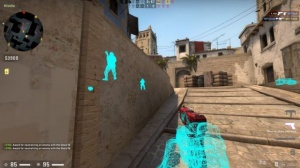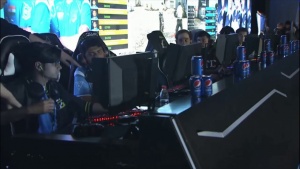Difference between revisions of "Cheating in eSports"
| Line 1: | Line 1: | ||
'''Cheating in eSports''' entails using unauthorized entities, virtual or physical, in order to gain an advantage over their opponents or for personal gain. Examples of such entities include unauthorized software, hardware modifications, and performance-enhancing drugs. Other, less direct types of cheating include breaking a game's Terms of Service (TOS) and match-fixing. As videogame competitions start to gain popularity and prize pools keep increasing, there is a tremendous incentive for players to cheat in order to gain notoriety and money. Most major competitive titles have their own cheat-detecting systems. Notable examples include Valve's Valve Anti Cheat (VAC), BattlEye, and Easy Anti-Cheat. | '''Cheating in eSports''' entails using unauthorized entities, virtual or physical, in order to gain an advantage over their opponents or for personal gain. Examples of such entities include unauthorized software, hardware modifications, and performance-enhancing drugs. Other, less direct types of cheating include breaking a game's Terms of Service (TOS) and match-fixing. As videogame competitions start to gain popularity and prize pools keep increasing, there is a tremendous incentive for players to cheat in order to gain notoriety and money. Most major competitive titles have their own cheat-detecting systems. Notable examples include Valve's Valve Anti Cheat (VAC), BattlEye, and Easy Anti-Cheat. | ||
| + | |||
| + | ==Explicit Cheating== | ||
| + | ===Software=== | ||
| + | [[Image:Wallhacks.jpg|thumb|c|300px|Wallhack exploit for Counter-Strike: Global Offensive]] | ||
| + | Cheating via the use of software implies that the player uses unauthorized third-party programs that enhance their performance. This is the most prevalent type of cheating in eSports and game developers have taken measures to discourage the use of third-party software. Modern anti-cheats identify all types of third-party software, even if they are not intended to be used as cheating mechanics. Sanctions for using unauthorized software vary by severity and among game developers, too. | ||
| + | |||
| + | '''Wallhacks''' allow players to see the silhouettes of all players through environmental terrain. These types of hacks provide an advantage to the user by providing vital information about the location of enemies at all times. If the software passes the anti-cheat check, it is fairly hard to detect if a user is using this type of exploit. In these cases, detecting players with this exploit revolves around a "reporting" feature, where players can report a suspected cheater, which will then be reviewed by a human individual. Players convicted of using wallhacks are usually given a suspension from the game, where the duration is determined by the severity and usage of the software. | ||
| + | |||
| + | '''Aim assistance''', usually prevalent in shooting games, enhance its users' aiming capabilities. This removes the need to practice aiming, as the software will help the user lock on to their targets. Aim assistance software comes in various forms. The most prevalent type are '''aimbots''', which keep a player's crosshair locked on to their targets, usually towards their head. Aimbots are easier to detect, usually by spectating a suspected player. Similar to aimbots, '''triggerbots''' assist a player with target acquisition. However, unlike aimbots, triggerbots do not keep a player's crosshair locked. Instead, triggerbots automatically shoot when a player's crosshair is over an enemy target. Triggerbots in certain games, such as Counter-Strike: Global Offensive, also automatically stop your movement prior to shooting in order to guarantee the accuracy of the shot. | ||
| + | [[Image:Forsaken.jpg|thumb|c|300px|Forsaken, furthermost left, a professional Counter-Strike: Global Offensive player, caught cheating at eXTREMESLAND 2018 Asia Finals]] | ||
| + | |||
| + | '''Scripting/Macros''' are a series of commands run in quick succession, usually through a text file. Since these commands are executed faster than the actions of a human being, using scripts/macros provide an unfair advantage. Players can also write scripts to create bots that perform sequential tasks. Notable scripts include bunnyhop scripts in the Counter-Strike series, which allow a player to move at speeds faster than running, and rapid-fire scripts, which attempt to register multiple mouse clicks in order to shoot faster. It is important to note, that many scripts are used to make a challenging task possible, such as in the case of the bunnyhop script. Many players have mastered bunnyhopping through practice. Because of the high skill cap for this feature, running a script allows any player to perform the bunnyhop. | ||
Revision as of 17:10, 13 March 2020
Cheating in eSports entails using unauthorized entities, virtual or physical, in order to gain an advantage over their opponents or for personal gain. Examples of such entities include unauthorized software, hardware modifications, and performance-enhancing drugs. Other, less direct types of cheating include breaking a game's Terms of Service (TOS) and match-fixing. As videogame competitions start to gain popularity and prize pools keep increasing, there is a tremendous incentive for players to cheat in order to gain notoriety and money. Most major competitive titles have their own cheat-detecting systems. Notable examples include Valve's Valve Anti Cheat (VAC), BattlEye, and Easy Anti-Cheat.
Explicit Cheating
Software
Cheating via the use of software implies that the player uses unauthorized third-party programs that enhance their performance. This is the most prevalent type of cheating in eSports and game developers have taken measures to discourage the use of third-party software. Modern anti-cheats identify all types of third-party software, even if they are not intended to be used as cheating mechanics. Sanctions for using unauthorized software vary by severity and among game developers, too.
Wallhacks allow players to see the silhouettes of all players through environmental terrain. These types of hacks provide an advantage to the user by providing vital information about the location of enemies at all times. If the software passes the anti-cheat check, it is fairly hard to detect if a user is using this type of exploit. In these cases, detecting players with this exploit revolves around a "reporting" feature, where players can report a suspected cheater, which will then be reviewed by a human individual. Players convicted of using wallhacks are usually given a suspension from the game, where the duration is determined by the severity and usage of the software.
Aim assistance, usually prevalent in shooting games, enhance its users' aiming capabilities. This removes the need to practice aiming, as the software will help the user lock on to their targets. Aim assistance software comes in various forms. The most prevalent type are aimbots, which keep a player's crosshair locked on to their targets, usually towards their head. Aimbots are easier to detect, usually by spectating a suspected player. Similar to aimbots, triggerbots assist a player with target acquisition. However, unlike aimbots, triggerbots do not keep a player's crosshair locked. Instead, triggerbots automatically shoot when a player's crosshair is over an enemy target. Triggerbots in certain games, such as Counter-Strike: Global Offensive, also automatically stop your movement prior to shooting in order to guarantee the accuracy of the shot.
Scripting/Macros are a series of commands run in quick succession, usually through a text file. Since these commands are executed faster than the actions of a human being, using scripts/macros provide an unfair advantage. Players can also write scripts to create bots that perform sequential tasks. Notable scripts include bunnyhop scripts in the Counter-Strike series, which allow a player to move at speeds faster than running, and rapid-fire scripts, which attempt to register multiple mouse clicks in order to shoot faster. It is important to note, that many scripts are used to make a challenging task possible, such as in the case of the bunnyhop script. Many players have mastered bunnyhopping through practice. Because of the high skill cap for this feature, running a script allows any player to perform the bunnyhop.

